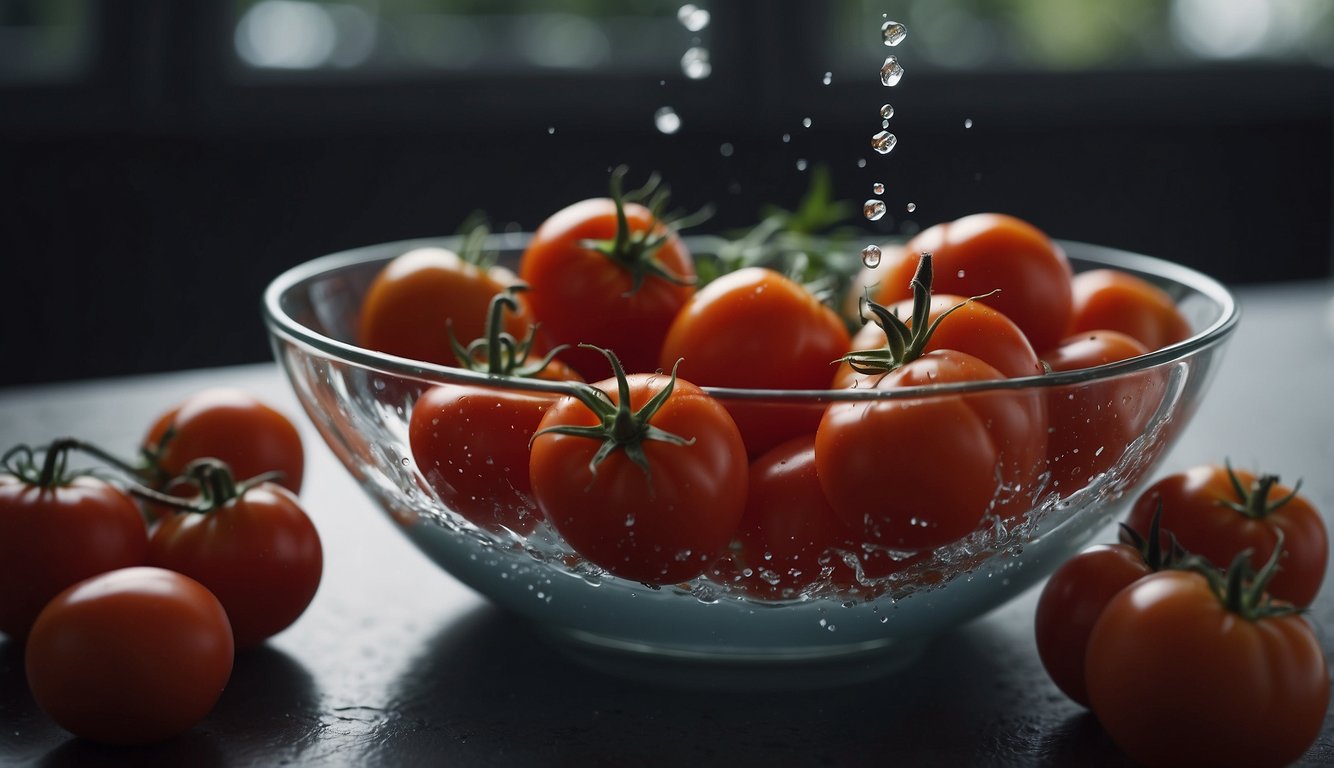Feeding tomatoes is essential for growing healthy, productive plants. As a gardener, I’ve learned tomatoes are heavy feeders. They need a steady supply of nutrients throughout their growth cycle. Proper feeding promotes strong root development, healthy foliage, and abundant fruit production. In this article, I’ll share my knowledge and experience on how to feed tomatoes for optimal growth and yield.
Tomatoes require a balanced supply of essential nutrients, including nitrogen, phosphorus, and potassium, as well as trace elements such as calcium, magnesium, and iron. These nutrients are necessary for various stages of tomato growth, from seedling to fruiting. However, feeding tomatoes is not a one-size-fits-all approach. There are different fertilizers and feeding methods that gardeners can use, depending on the type of soil, the stage of growth, and the variety of tomato plants. In this article, I will explain the different types of fertilizers, how to apply them, and when to feed tomatoes for optimal results.
By following the right feeding regime, gardeners can ensure their tomato plants grow healthy and produce bountiful fruit. Feeding tomatoes is a crucial aspect of gardening that requires attention to detail and care. In the next section, I will delve into the different types of fertilizers and how to choose the best one for your tomato plants.
Understanding Tomato Plant Needs
As a tomato grower, it is essential to understand the nutrient requirements and soil health of your plants. In this section, I will discuss the key factors that contribute to the health and growth of tomato plants.
Nutrient Requirements
Tomato plants have specific nutrient requirements to produce healthy and high-quality fruit. The three macronutrients that are essential for tomato plants are nitrogen (N), phosphorus (P), and potassium (K). Nitrogen is necessary for leaf growth, while phosphorus is crucial for root development and fruit production. Potassium is essential for overall plant health, stress tolerance, and fruit quality.
In addition to macronutrients, tomato plants also require micronutrients, such as calcium (Ca), magnesium (Mg), and iron (Fe). These micronutrients play a vital role in the plant’s growth and development, and their deficiency can cause significant damage to the plant.
Soil Health and Testing
Soil health is another crucial factor that affects the growth and development of tomato plants. The soil should be well-draining, rich in organic matter, and have a pH level between 6.0 and 7.0. A pH level outside this range can cause nutrient deficiencies, which can negatively impact the plant’s growth and yield.
It is essential to test your soil regularly to ensure that it has the necessary nutrients and pH level. You can use a soil test kit to determine the pH level and nutrient content of your soil. Based on the results, you can add the necessary nutrients to the soil to ensure that your tomato plants have everything they need to grow healthy and strong.
Understanding the nutrient requirements and soil health of tomato plants is essential for their growth and development. By providing the necessary nutrients and maintaining the soil’s health, you can ensure that your plants produce healthy and high-quality fruit.
Choosing the Right Fertilizer
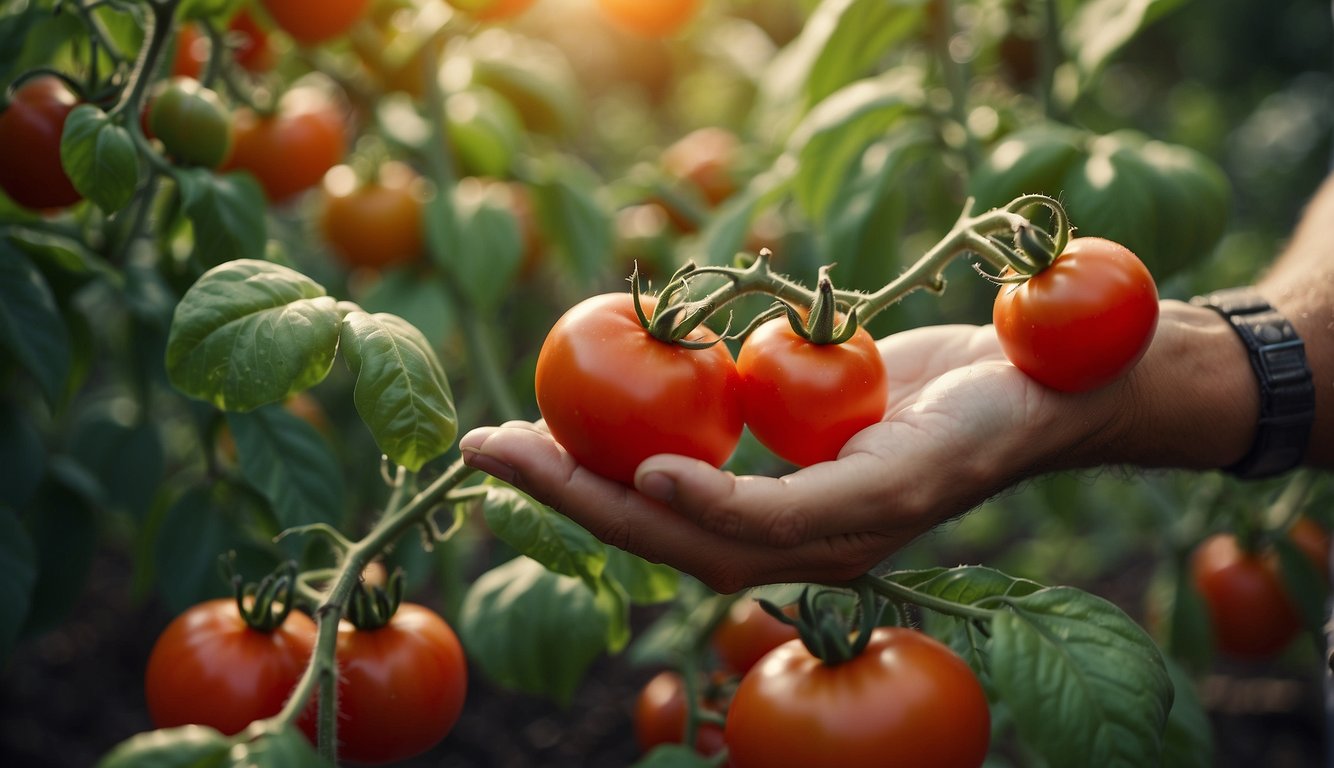
As a tomato grower, choosing the right fertilizer is crucial to ensure a healthy and productive tomato harvest. Here are some factors to consider when selecting a fertilizer for your tomato plants.
Organic vs. Synthetic Fertilizers
One of the first decisions you’ll need to make is whether to use organic or synthetic fertilizers. Organic fertilizers, such as compost, bone meal, and fish emulsion, are derived from natural sources and provide slow-release nutrients to the soil. On the other hand, synthetic fertilizers, like ammonium nitrate, are made from chemical compounds and provide a quick boost of nutrients to the plants.
Both types of fertilizers have their advantages and disadvantages. Organic fertilizers are generally more sustainable and environmentally friendly, but they can be more expensive and take longer to release nutrients. Synthetic fertilizers are cheaper and provide quick results, but they can also harm the environment if not used properly.
NPK Ratio and Balanced Fertilizers
When choosing a fertilizer, it’s important to pay attention to the NPK ratio. NPK stands for nitrogen, phosphorus, and potassium, which are the three primary nutrients that plants need to grow. The ratio of these nutrients in a fertilizer will determine its effectiveness for tomato plants.
For example, a fertilizer with a ratio of 5-10-5 will contain 5% nitrogen, 10% phosphorus, and 5% potassium. This type of fertilizer is often recommended for tomatoes because it promotes healthy root growth and fruit development.
It’s also important to choose a balanced fertilizer that contains a mix of nutrients, rather than just one or two. This will ensure that the plant is getting all the nutrients it needs for optimal growth.
Specialized Tomato Fertilizers
There are also specialized fertilizers designed specifically for tomato plants. These fertilizers are formulated with the specific nutrient needs of tomato plants in mind, and can help improve yields and overall plant health.
Tomato fertilizers often contain higher levels of potassium, which can help improve fruit quality and flavor. Some tomato fertilizers also contain calcium, which can help prevent blossom end rot, a common problem for tomato plants.
Choosing the right fertilizer for your tomato plants is crucial for a successful harvest. Consider the type of fertilizer, the NPK ratio, and whether a specialized tomato fertilizer is necessary for optimal plant health.
Feeding Schedule and Techniques – Feeding Tomatoes
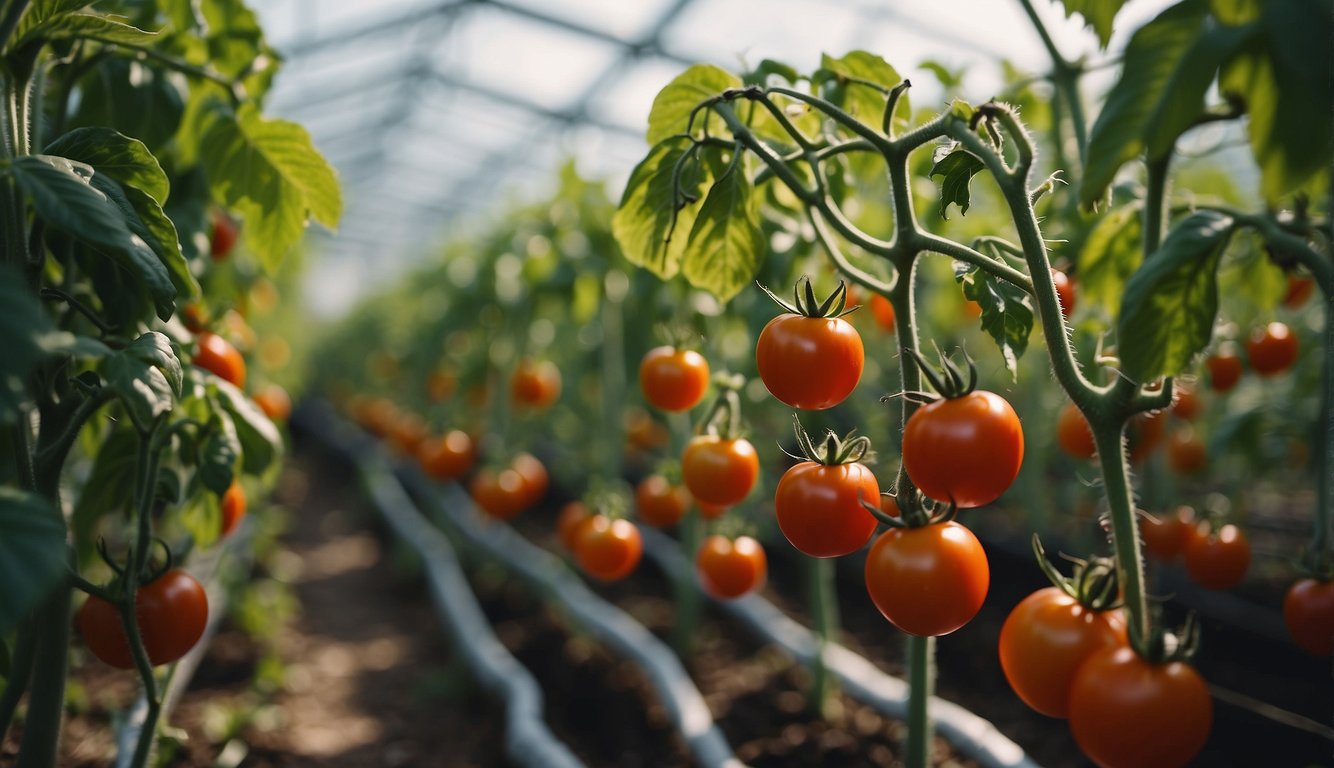
As an experienced gardener, I have found that tomatoes are heavy feeders and require a consistent feeding schedule to produce a bountiful harvest. In this section, I will share my knowledge on when and how to fertilize tomatoes to ensure healthy plants and a bumper crop.
When to Fertilize
It is important to fertilize tomatoes at the right time to avoid overfeeding or underfeeding. I recommend fertilizing tomatoes twice during the growing season: once at planting and again when the plants start to flower.
For seedlings, it is best to wait until they have developed their first true leaves before fertilizing. This will prevent burning the delicate roots and ensure healthy growth. Once the plants are mature, they should be fertilized every 4-6 weeks to promote fruit development.
How to Apply Fertilizers – Feeding Tomatoes
There are several ways to apply fertilizers to tomatoes, including granular, liquid, and foliar applications. Granular fertilizers are applied to the soil around the base of the plants and worked into the soil. Liquid fertilizers can be applied directly to the soil or as a foliar spray. Foliar sprays are applied to the leaves of the plant and absorbed through the leaves.
When applying fertilizers, it is important to follow the manufacturer’s instructions and not overfeed the plants. Overfeeding can lead to excessive foliage growth and poor fruit development. It is also important to water the plants thoroughly after fertilizing to ensure the nutrients are absorbed by the roots.
Fertilizing Seedlings vs. Mature Plants
Seedlings have different nutrient requirements than mature plants. When fertilizing seedlings, it is important to use a balanced fertilizer with equal amounts of nitrogen, phosphorus, and potassium. This will promote healthy root growth and strong stems.
Mature plants, on the other hand, require more phosphorus and potassium to promote flowering and fruit development. A fertilizer with a higher middle number (phosphorus) is recommended for mature plants.
Feeding tomatoes is essential to ensure healthy growth and a bumper crop. By following a consistent feeding schedule and using the right fertilizers, seedlings and mature plants can thrive and produce an abundance of delicious tomatoes.
Common Tomato Plant Issues – Feeding Tomatoes
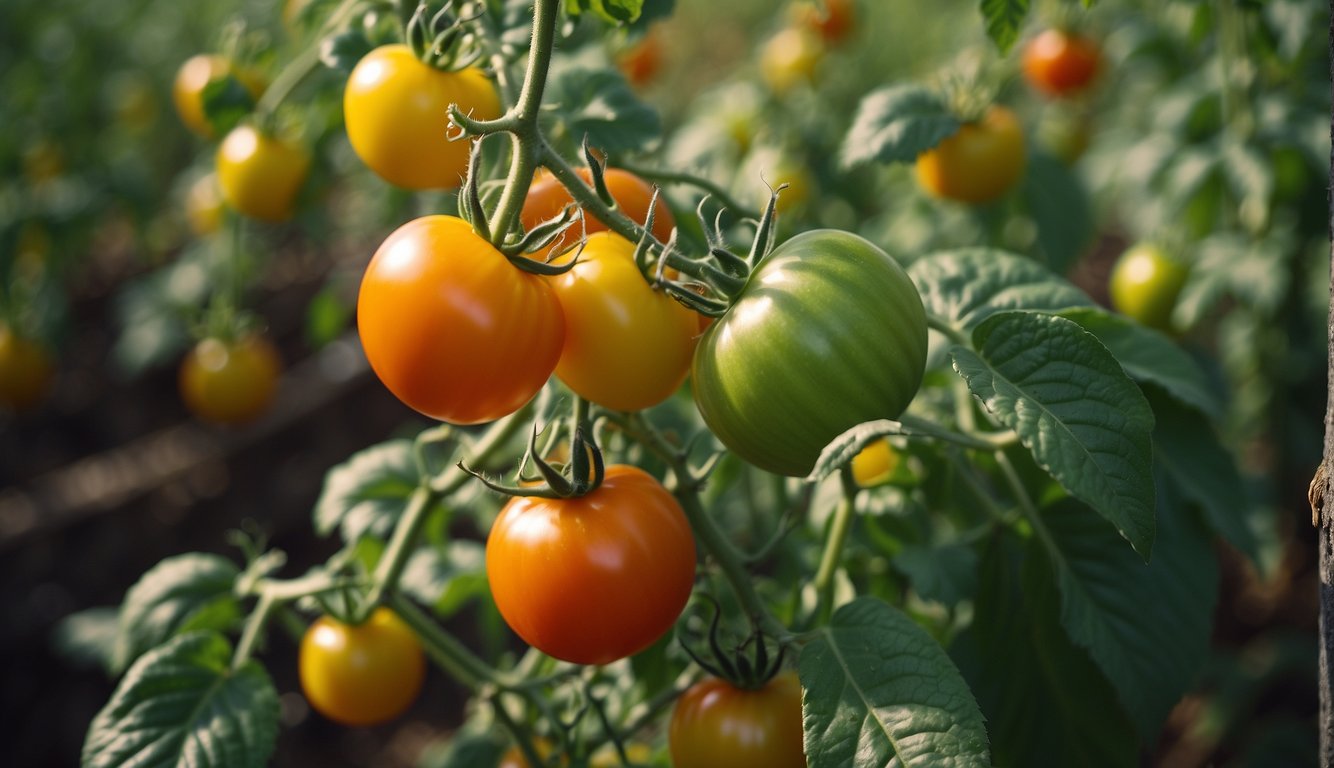
As a tomato grower, it’s important to know the common tomato plant issues that can arise during the growing season. Here are some of the most common issues and how to prevent and treat them.
Identifying Nutrient Deficiencies
One of the most common issues that tomato growers face is nutrient deficiencies. When tomato plants don’t get the right nutrients, they can become stunted, have yellowing leaves, and produce fewer fruits.
To prevent nutrient deficiencies, it’s important to use a balanced fertilizer that contains all the essential nutrients that tomato plants need. Nitrogen, phosphorus, and potassium are the three main nutrients that tomato plants need in large amounts. However, they also need other micronutrients like calcium, magnesium, and iron.
Preventing and Treating Blossom End Rot – Feeding Tomatoes
Blossom end rot is another common issue that tomato growers face. It’s a condition that causes the bottom of the tomato fruit to turn black and become leathery.
Blossom end rot is caused by a lack of calcium in the soil. To prevent blossom end rot, it’s important to make sure that your soil has enough calcium. You can add calcium to your soil by using a calcium-rich fertilizer or by adding crushed eggshells to the soil.
If you notice blossom end rot on your tomato plants, it’s important to remove the affected fruits and discard them. You can also prevent further damage by adding calcium to the soil and making sure that your plants are getting enough water.
Avoiding Overfertilization and Root Burn
Overfertilization and root burn can also be issues for tomato growers. When tomato plants are overfertilized, they can develop root burn, which can cause the roots to die and the plants to wilt.
To avoid overfertilization and root burn, it’s important to follow the instructions on your fertilizer package carefully. Don’t apply more fertilizer than recommended, and make sure that you water your plants thoroughly after fertilizing.
Identifying nutrient deficiencies, preventing and treating blossom end rot, and avoiding overfertilization and root burn are some of the most common tomato plant issues that you may face. By taking the necessary steps to prevent and treat these issues, you can ensure that your tomato plants grow healthy and produce plenty of delicious fruits.
Homemade and Natural Fertilizer Options – Feeding Tomatoes
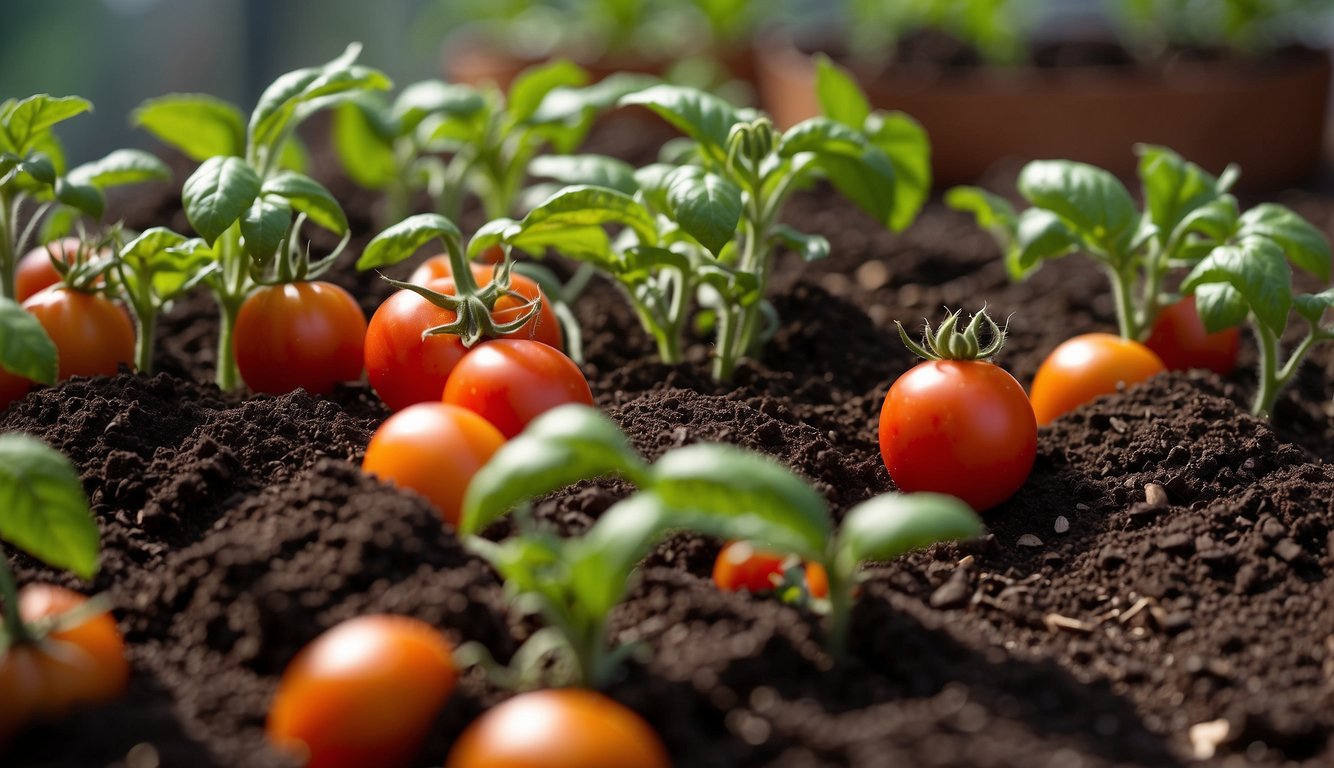
As a gardener, I prefer to use homemade and natural fertilizers on my tomato plants. These options are not only cost-effective but also environmentally friendly. Here are some of my favorite homemade and natural fertilizer options for tomatoes:
Using Compost and Compost Tea – Feeding Tomatoes
Compost is a great soil amendment that provides essential nutrients to plants. It is also easy to make at home using kitchen scraps, yard waste, and other organic materials. Simply layer these materials in a compost bin and let nature do the rest. Once the compost is ready, you can use it as a top dressing or mix it into the soil.
Compost tea is another great option that can be made using compost and water. To make compost tea, simply steep compost in water for a few days and strain the liquid. This liquid can then be used to water your tomato plants and provide them with essential nutrients.
Alternative Nutrient Sources
Aside from compost and compost tea, there are other alternative nutrient sources that you can use to fertilize your tomato plants. Here are some of my favorite options:
- Composted manure: This is a great option for providing nitrogen to your plants. Just be sure to use well-aged manure to avoid burning your plants.
- Organic tomato fertilizer: There are many organic tomato fertilizers available on the market that are made with natural ingredients such as fish emulsion, kelp meal, and alfalfa meal.
- Epsom salt: This can be used as a source of magnesium and sulfur for your plants. Simply dissolve a tablespoon of Epsom salt in a gallon of water and use it to water your plants.
- Coffee grounds: These can be used as a source of nitrogen and other nutrients. Simply sprinkle them around the base of your plants.
- Eggshells: These can be crushed and added to the soil to provide calcium to your plants.
By using these homemade and natural fertilizer options, you can ensure that your tomato plants are getting the nutrients they need to thrive.
Tomato Plant Lifecycle and Fertilization – Feeding Tomatoes
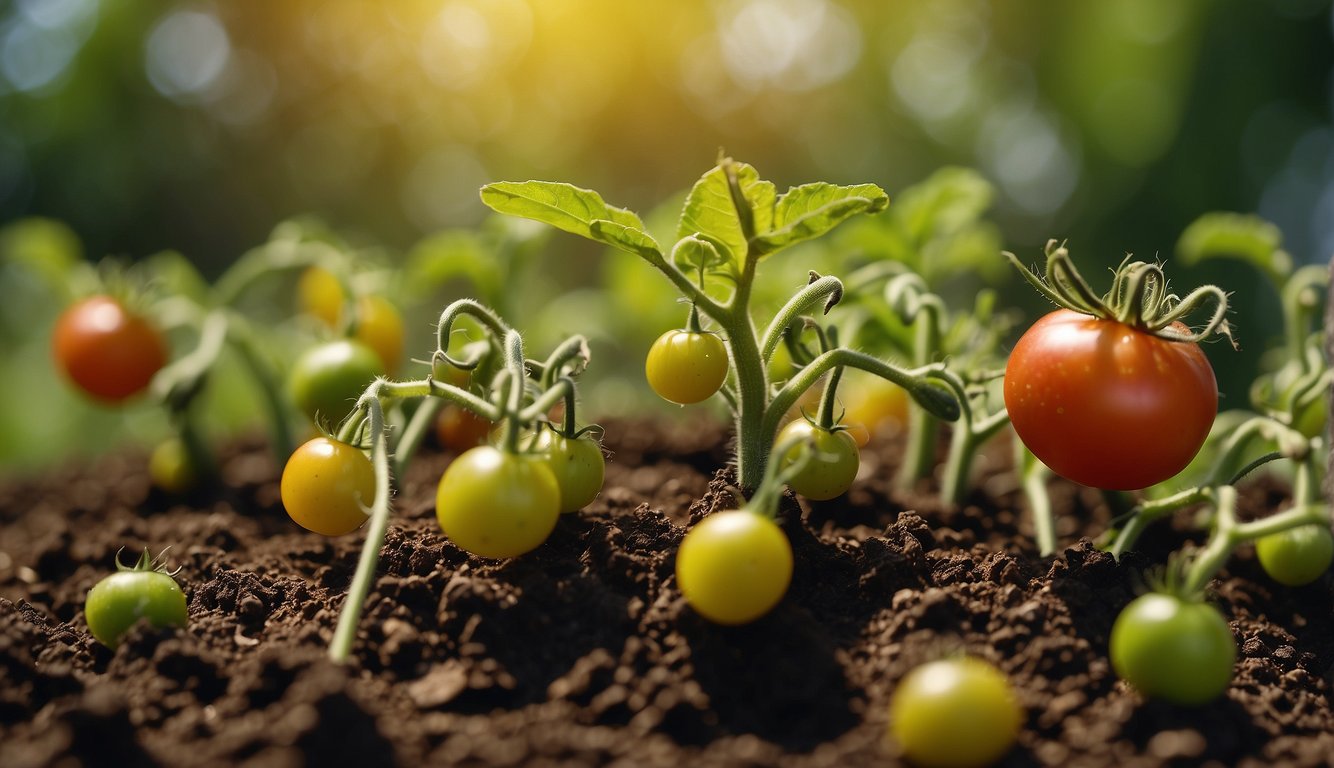
As a tomato plant grows from seedling to harvest, its nutrient needs change. Proper fertilization is key to ensuring healthy growth and a bountiful harvest. In this section, I will discuss the tomato plant lifecycle and how to adjust feeding for each stage.
From Seedling to Harvest – Feeding Tomatoes
Tomatoes can be grown from seed or purchased as seedlings. When starting from seed, it is important to provide a nutrient-rich soil mix to give the seedlings the best start. As the seedlings grow, they will need to be transplanted into larger containers or the ground. This is a critical time for the plant, as it is establishing its root system. Providing a balanced fertilizer, such as a 10-10-10 mix, can help promote healthy root growth.
Once the plant is established, it will begin to focus on vegetative growth and setting fruit. During this stage, a fertilizer with a higher nitrogen content, such as a 20-10-10 mix, can help promote leafy growth. However, too much nitrogen can lead to excessive vegetative growth and delay fruit set. It is important to strike a balance and not over-fertilize.
As the plant begins to set fruit, it will require more phosphorus and potassium. A fertilizer with a 5-10-10 or 10-20-20 mix can help promote healthy fruit development. It is important to avoid fertilizing too close to harvest, as excessive nitrogen can lead to bland-tasting fruit.
Adjusting Feeding for the Growing Season
As the growing season progresses, it is important to adjust feeding to meet the changing needs of the plant. During periods of drought or high temperatures, the plant may require more frequent watering and feeding. Conversely, during periods of heavy rain or cooler temperatures, the plant may require less water and feeding.
It is also important to monitor the plant for signs of nutrient deficiencies or excesses. Yellowing leaves may indicate a lack of nitrogen, while brown leaf edges may indicate excess salt buildup from over-fertilization. Adjust feeding accordingly to address these issues.
Proper fertilization is key to ensuring healthy growth and a bountiful harvest for tomato plants. By understanding the changing nutrient needs throughout the plant’s lifecycle and adjusting feeding accordingly, gardeners can grow healthy, productive plants.
Fertilizing Tomatoes in Different Environments – Feeding Tomatoes
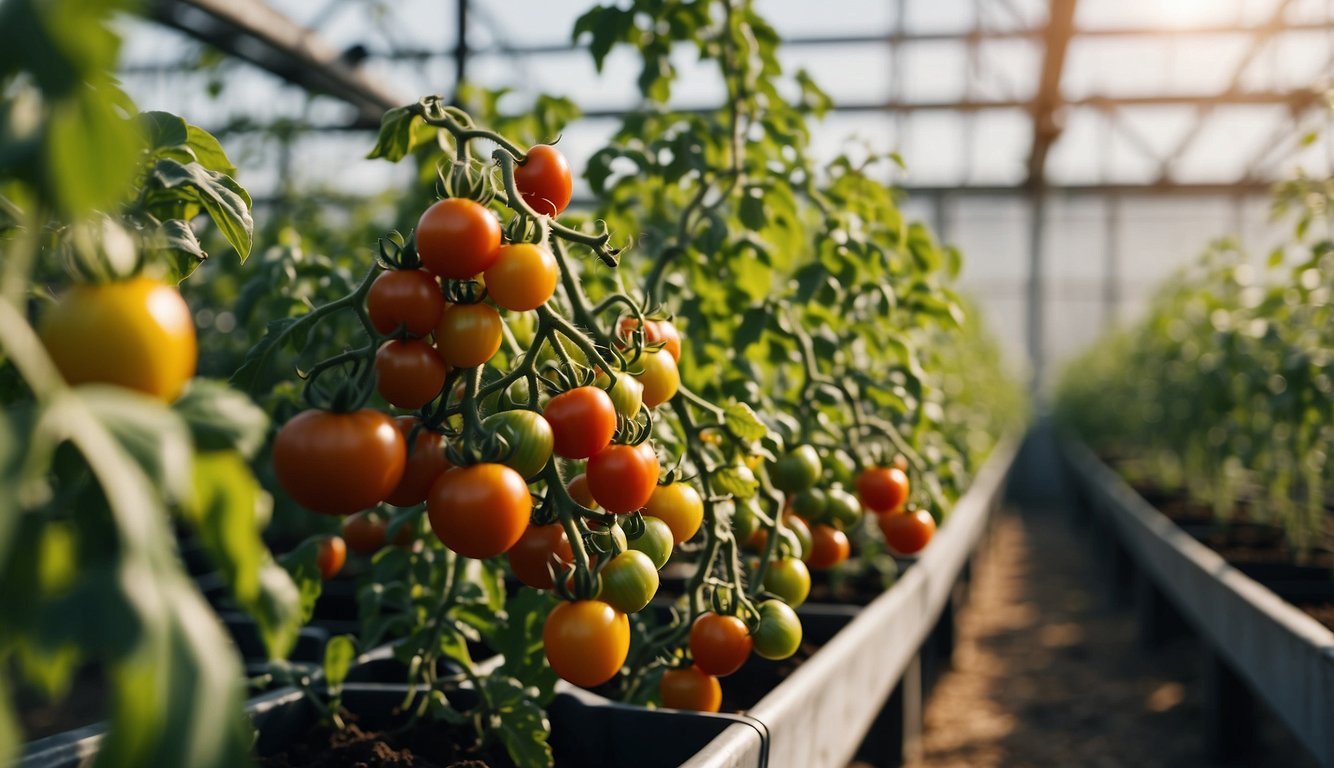
Growing tomatoes in different environments require different fertilizing techniques. In this section, I will discuss how to fertilize tomatoes in in-ground gardens and container and pot gardening.
In-Ground Gardens – Feeding Tomatoes
In-ground gardens require a different fertilizing technique than container and pot gardening. Before planting tomatoes in an in-ground garden, it is essential to test the soil’s pH level to determine the appropriate fertilizer. Tomatoes require a pH level between 6.0 and 7.0 to grow optimally. If the soil’s pH level is too low, add lime to increase it. If it is too high, add sulfur to lower it.
Tomatoes require nitrogen, phosphorus, and potassium to grow. Nitrogen is essential for foliage growth, phosphorus for root development, and potassium for fruit production. When fertilizing tomatoes in an in-ground garden, it is essential to use a balanced fertilizer that contains all three nutrients in equal amounts. Apply the fertilizer according to the package instructions, and make sure to water the plants thoroughly after application.
Container and Pot Gardening
Container and pot gardening require a different fertilizing technique than in-ground gardens. When growing tomatoes in containers or pots, it is essential to choose a container with adequate drainage. Tomatoes require well-draining soil to grow optimally. If the soil does not drain well, it can lead to root rot and other plant diseases.
When fertilizing tomatoes in containers or pots, it is essential to use a water-soluble fertilizer. Water-soluble fertilizers are easy to apply and provide nutrients to the plants quickly. Apply the fertilizer according to the package instructions, and make sure to water the plants thoroughly after application.
Fertilizing tomatoes in different environments require different techniques. When growing tomatoes in in-ground gardens, it is essential to test the soil’s pH level and use a balanced fertilizer. When growing tomatoes in containers or pots, it is essential to choose a container with adequate drainage and use a water-soluble fertilizer.
Feeding Tomatoes
Today, we’re digging into the delicious world of feeding tomatoes. Get ready, it’s going to be a fruitful journey!
Firstly, let’s talk about fertilizer. Tomatoes are heavy feeders and love a rich, organic compost. It’s like a five-star meal for your plants!
Next, the watering part. Tomatoes need consistent watering. Too much or too little, and you could end up with split fruits or blossom end rot. It’s all about balance!
And here’s a fun fact! Tomatoes love calcium. Adding some crushed eggshells to your soil can give your tomatoes a calcium boost. It’s like a vitamin supplement for your plants!
So, next time you’re tending to your tomatoes, remember these feeding tips. Your tomatoes will thank you with a bountiful harvest!
For more tomato-growing wisdom, do visit the website theherbprof.com. Keep it tasty, folks!
References – Feeding Tomatoes
Little Herb Encyclopedia, by Jack Ritchason; N.D., Woodland Publishing Incorporated, 1995
The Ultimate Healing System, Course Manual, Copyright 1985, Don Lepore
Planetary Herbology, Michael Tierra, C.A., N.D., Lotus Press, 1988
Handbook of Medicinal Herbs, by James A. Duke, Pub. CRP Second Edition 2007
The Complete Medicinal Herbal, by Penelope Ody, Published by Dorling Kindersley
Check the Following Articles!
Diatomaceous Earth Wet: How to Use and Apply It Safely
How to Clean Up Grass Clippings: Tips and Tricks
Weird Vegetables to Grow: Unique and Uncommon Varieties
Frequently Asked Questions – Feeding Tomatoes

What is the optimal NPK ratio for healthy tomato growth?
The optimal NPK ratio for tomato growth is 5-10-10. Nitrogen (N) is essential for leaf growth, while phosphorus (P) and potassium (K) help with flower and fruit development. However, the ratio may vary depending on the type of soil and the stage of growth.
Can homemade fertilizers be effective for tomato plants, and how are they made?
Homemade fertilizers can be effective for tomato plants. One option is to use compost, which is made by combining organic materials such as leaves, grass clippings, and vegetable scraps. Another option is to use a mixture of Epsom salt, baking soda, and ammonia. However, it is important to use homemade fertilizers in moderation and to test the soil regularly to avoid over-fertilization.
When is the best time to cease fertilizing tomato plants in containers?
The best time to cease fertilizing tomato plants in containers is when the fruit begins to ripen. At this point, the plant has already received enough nutrients and any additional fertilization may result in over-fertilization, which can damage the plant.
How frequently should tomato plants in pots be fertilized?
Tomato plants in pots should be fertilized every two to three weeks during the growing season. However, the frequency may vary depending on the type of fertilizer used and the stage of growth.
What specific nutrients should tomatoes receive during the fruiting stage?
During the fruiting stage, tomatoes require higher levels of potassium (K) and phosphorus (P) to promote fruit development. Additionally, they require calcium (Ca) to prevent blossom end rot, a common disorder in tomatoes.
Are there any benefits to using organic fertilizers on tomato plants, and what are the best options?
Using organic fertilizers on tomato plants has several benefits, including improved soil health, reduced environmental impact, and increased nutrient availability. Some of the best organic fertilizers for tomatoes include compost, worm castings, and fish emulsion.
